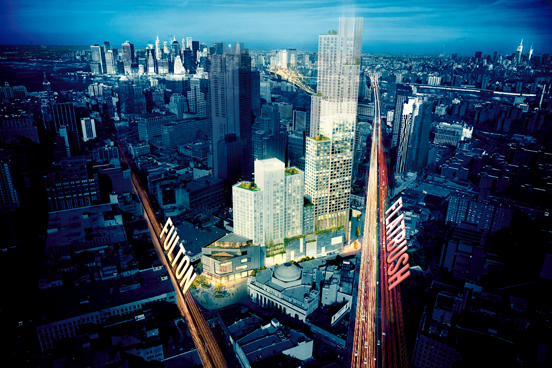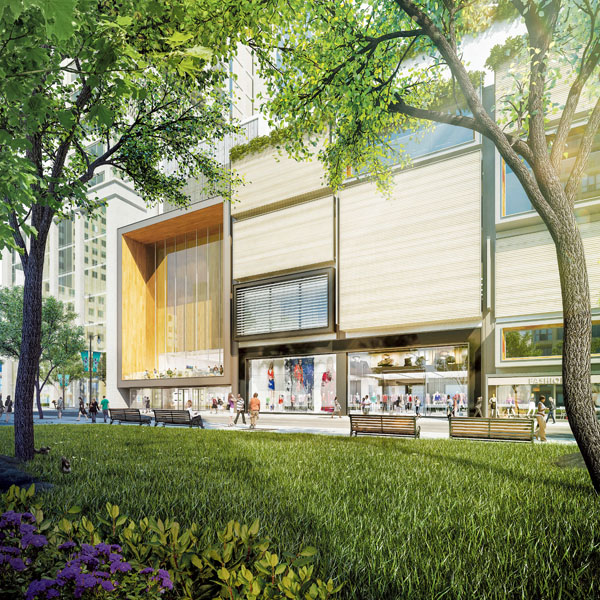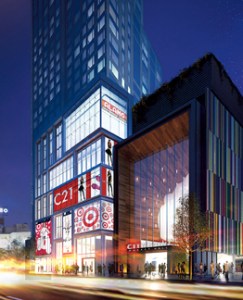Developers Show 2020 Vision at City Point
By Tobias Salinger December 3, 2014 12:00 pm
reprints

You could say it took Paul Travis and Christopher Conlon 10 years to get to the Point.
We’re talking, of course, about City Point.
They’re the developers implementing the vision that city planners laid out as far back as the Bloomberg administration’s 2004 rezoning of Downtown Brooklyn.
But the upzoning of Downtown Brooklyn is its own saga that extends even further back. It followed an extensive 1983 study of the area by the Regional Plan Association, a 1986 plan from the city Department of Housing Preservation and Development that would turn into MetroTech Center and the 2001 designation of a special district that yielded the Brooklyn Cultural District around the Brooklyn Academy of Music. The 2004 effort would facilitate 6.7 million square feet of new development, including 4.6 million square feet of office space, 979,000 square feet of residential development and 844,000 square feet of retail, the rezoning’s final environmental impact statement predicted.
And one way the city would support such new building, the 2004 planning study notes, would be to “allow the development of property on the south side of Willoughby Street between Albee Square West/Gold Street and Flatbush Avenue Extension.” These days, that site is turning into the massive undertaking known as City Point.

Mr. Travis, the managing partner of Washington Square Partners, and Mr. Conlon, the executive vice president and chief operating officer of Acadia Realty Trust, are spearheading the effort to create a 675,000-square-foot shopping center spread over five above-grade floors along with three adjoining residential towers that could hold nearly 1,000 residential units, once the development partnership completes the project’s three phases. The Albee Square Development team, which also now includes Tower 1 residential partner BFC Partners, is moving through the second stage of the development with leases signed for anchor tenants Century 21, CityTarget and Alamo Drafthouse, another deal in the works for an operator at a food market onsite called Dekalb Market, one residential building topped out and another rising up. When all is said and done, the development will sprawl 1.8 million square feet and feature 30,000 square feet of office space.
“One choice we made here was to build a building of a level of density and quality that no one’s ever done,” Mr. Travis said as workers banged away on the future Alamo Drafthouse on the fifth story of the shopping center. “Probably the best comparison is the Time Warner Center. The response from retailers who have toured it is that they’ve never seen anything like this.”
The complex by COOKFOX Architects certainly represents a large-scale approach. The Armani Exchange currently operates a store in an existing retail site at 1 Dekalb Avenue near Fulton Street, but that store, which constituted City Point’s first phase, will soon give way to the shopping center. The schedule calls for Century 21 and Alamo to open next year and Target to open its urban-oriented CityTarget concept in 2016, Mr. Conlon said. The 250-unit, 50-percent affordable BFC tower and the 440-unit market-rate rental by the Brodsky Organization will also be online for a grand opening event for the second phase in March 2016, if all goes according to plan, Mr. Conlon noted. Construction on the third tower, where a residential developer partner hasn’t been formally announced, won’t begin until 2017, he said.
But the entire development must be finished by 2020 due to the terms of Albee Square Development’s lease with the city, the partners said. The project picked up $20 million worth of tax exempt recovery zone facility bonds through the federal stimulus program in 2009 and the partnership has assumed full development rights for the site, according to the city’s Economic Development Corporation. City planners’ ideas for the property are coming to fruition thanks to the Albee Square partners, Kyle Kimball, the president of the EDC, told Commercial Observer.
“The vision of this project was to turn a dilapidated mall and an underutilized space into a vibrant mixed-use development,” Mr. Kimball said, adding that City Point will be “one of the gems” of the revitalized Downtown Brooklyn area. “It’s really a testament to the developers that we are where we are today. They really worked hard during a tough time for development. They really took a big risk, and I think it’s going to pay off.”

Acadia and project manager Washington Square entered into a lease with the city in 2007 that expires in 2078 after purchasing a lease for the now-demolished Gallery at Fulton Street (the former Albee Square Mall) from Joseph Sitt’s Thor Equities, EDC officials said, declining to disclose the cost structures of the two transactions. The partners also declined to state a direct cost of the arrangement, saying only that their investment in the transaction to acquire the lease from Mr. Sitt was “significant but less” than the reported purchase price of $125 million and that the lease with the city carries a purchase option before its expiration date. They also declined to indicate how much it cost the residential developers to buy into the project beyond stating that BFC became a partner at the end of last year “to create a financeable project with affordable housing.”
But the real estate investment trust, White Plains-based Acadia, whose latest annual report cites City Point as the company’s largest development project, has spent $249.5 million on the site and plans to expend $30.5 million to $60.5 million more, the report says. The company allotted $17.2 million in prepaid ground rent at City Point in 2013, according to the report.
Regardless of the pricing in the complex arrangement, the steel and concrete now at the site represent its significant progress. Mr. Travis, who worked at Forest City Ratner when the company owned the mall, approached Acadia when the site hit the market, the partners said. The financial crisis of 2008 provoked a prior lead partner to back out, causing a delay and vacuum that would actually turn out to benefit the development team, Mr. Conlon said.
“We had this rain delay—there was this recess,” he said. “As we took control ourselves, we watched as the renaissance of Brooklyn, and of Downtown Brooklyn in particular, have allowed us to create something that will be very special.”
Shoppers and commuters will definitely net new options out of their creation. Century 21 will operate out of 125,000 square feet on the third and fourth floors, while CityTarget will mark the second floor with a 125,000-square-foot space of its own.
On the fifth floor, the Austin, Texas-based Alamo Drafthouse will install seven theaters with a capacity of 830 seats offering the growing corporation’s selection of art house features and commercial fare with full food and drink menus during the films. The theater, which will be the company’s first New York City location, will also feature two bars, including one on an outdoor terraced balcony, the company’s founder and chief executive officer, Tim League, told CO after a recent visit to the property.
“The rail component of that site was interesting to me,” Mr. League said of the decision to sign on to the project four years ago. “I believed in it; I thought it was going to happen, but I knew that we would be able to reach into a lot of neighborhoods with that rail connectivity.”
Transportation goes hand in hand with the plans for the property. On the ground floor, a different kind of retail will line a new entrance to the Dekalb Avenue subway station for B,Q and R trains and a new corridor will connect Willoughby Street and Dekalb Avenue in an enclosed passageway. That ground floor will feature 10,000 to 20,000 square feet of restaurants and the 20,000-to 30,000-square-foot Dekalb Market, which will be the “best market hall in the borough,” Mr. Travis said. The partners are currently negotiating with a master operator with a vision to bring in Brooklyn purveyors to the market, although Mr. Conlon said they are “weeks away” from announcing the agreement.

Retail asking rents at City Point range from $75 to $250 per square foot, Mr. Conlon said, and the look of the complex will be unlike any the borough has ever seen.
“There was no way to get a sense of that when we were looking at it on paper,” he said. “It’s very rewarding, but also very surprising. This is special, this is different. You can’t produce this in older buildings—only in buildings produced in the 21st century.”
The retail onsite should benefit from a full complement of potential customers in the residential towers. Tower 1, the BFC development that will be the first to be completed, will offer 30 percent middle-income housing and 20 percent low-income apartments to go with the market-rate units that make up the other half. The 32-story Tower 2, which Brodsky closed on the rights to build last June, will represent the company’s first venture outside of Manhattan and feature amenity-laden studios to two-bedroom apartments, said Thomas Brodsky, a principal at the company.
“The Brodsky Organization has always been interested in the right opportunity to develop a property in Brooklyn,” Mr. Brodsky wrote in an email. “The caliber of the team behind this project and the location of the site presented us with the perfect opportunity to introduce the Brooklyn market to our firm’s longstanding expertise in developing and managing high-end residential properties.”
The third and tallest tower onsite has yet to take shape, with another of the city’s prolific real estate companies potentially in the mix to make its first entrance to Brooklyn. But speculation has abounded, with reports circulating that the building could supplant other new towers in the area as the tallest building in the borough. CO reported in September that Gary Barnett’s Extell Development Company is in contract to build the third tower, but representatives for the company declined to comment on the development rights purchase.
The projects’ partners declined to confirm or deny the arrangement, saying, “Phase 3 does not need to start construction until 2017, so we have a little time before we need to start the development process.”
Yet that tower will be just one of many that have popped up in the now-thriving downtown area. Mr. Travis pointed out a site across the street from City Point where Morris Bailey’s JEMB Realty has filed plans to build a 65-story tower at 420 Albee Square. Since the 2004 rezoning, Downtown Brooklyn has added 8 million square feet of new development, including 5,200 residential units, over 1,000 new hotel rooms, nearly 250,000 square feet of office space and 625,000 square feet of retail, according to a 10-year report by the Downtown Brooklyn Partnership. After the public sector invested $400 million in infrastructure, the private sector has spent $4 billion on new development, figures from the report say.
“When we purchased it, we were in a site that was in the middle of a downtown that was beginning to transform,” Mr. Travis said. “We were very focused at first on the neighborhoods around Downtown Brooklyn. What we didn’t know was that Downtown Brooklyn would transform so fast.”


